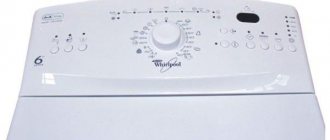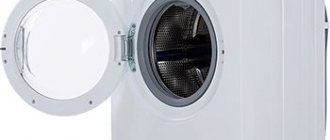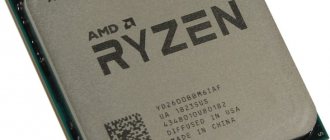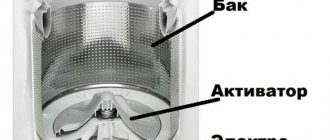When choosing a washing machine, like other large household appliances, we plan in advance where we will install it. Depending on this, we determine what the dimensions and other characteristics of the device will be.
The dimensions of the machines are primarily affected by the type of loading:
- Vertical - with an opaque drop-down loading hatch at the top of the machine.
- Frontal - with a transparent or solid loading hatch on the side, on the front side of the device.
Dimensions of front loading washing machines
Front-loading units are typically categorized along all three dimensions.
Standard width
of such washing machines is 59-60 cm.
Home machines that are wider are practically never found, but among professional models you can choose 70 cm units - for example, Miele PW 6080 Vario LP RU.
Smaller models can also be found in the Hausdorf store - for example, the compact Electrolux EWC1350 is only 49.5 cm wide.
Standard height
devices with horizontal loading - 85 ± 1 cm. This value was not chosen by chance: it is at this height of the tabletop that the least load on the hands and body is achieved for a person of average height who works at this table. Thus, the 85 cm high machine can be installed next to a table or other kitchen surface, which is important for free-standing devices.
In our store there are also machines of non-standard height: 67 cm for Electrolux EWC1350, 89 cm for Smeg LBB14PB-2, made in retro design in the style of the 50s, and the already mentioned Miele PW 6080 Vario LP RU reaches a height of 102 cm.
Depth
Side-loading washing machines are one of their main parameters. Its value depends on the volume of the loading drum, that is, on the weight of the laundry loaded for one washing cycle. Based on depth, all devices are divided into narrow, standard and deep.
Top loading washing machines
Thanks to the convenient location of the hatch, which is located on top, the vertical washing machine does not require additional space for loading laundry. A compact washing machine (width - 40-45 cm, depth - 60-65 cm) can easily fit in a cramped kitchen or in a small bathroom. A top-loading washing machine does not differ from a model with a front hatch in terms of functionality, reliability, or wash quality. The only difference is the design, dimensions and price.
There are several common myths about vertical machines: - Vertical drum bearings fail half as often. In fact, the bearings of any machine have the same service life, which is reduced by improper operation (exceeding the permissible volume, large particles of dirt getting into the seals, etc.). — You can load laundry into the vertical machine while washing. In fact, for many modern models this feature is “blocked” 5-10 minutes after loading. — Vertical machines vibrate and make less noise than front-loading machines. In reality, the level of noise and vibration does not depend on the loading method, but on the design features of the housing and tank.
Pros and cons of vertical washing machines
Saving space due to the top hatch is a significant advantage of vertical washing machines, which is emphasized by the owners of small kitchens and bathrooms. Other advantages of top-loading machines include: - ease of use - no need to bend over to load or remove things from the tank; — safety — the hatch is located out of the reach of children; — sufficient capacity — loading volume is up to 9 kg.
“Vertical” washing machines have their disadvantages: — prices set for vertical washing machines are higher than for front-facing models with similar characteristics; — the upper horizontal plane with the hatch cannot be used as an additional shelf; — it is impossible to observe the washing process.
Choosing a top-loading washing machine
Before buying a vertical washing machine, pay attention to the following points: - tank capacity - calculate the maximum capacity taking into account the number of family members (5 kg for 3-4 people); - energy consumption class - a model with class A consumes from 0.17 to 0.19 kW per hour (per 1 kg of laundry), the “+” icon next to the letter A “subtracts” 10% from this figure (A+ - from 0, 15 kW/h, A++ - from 0.13 kW/h). - number of revolutions during spinning - high speed is suitable for spinning dense and unpretentious fabrics (jeans, etc.), woolen and silk items should be pressed at low speeds; — spin quality — models with class A remove more than 55% of moisture from things (residual moisture is less than 45%); - washing programs and modes - colored items, cotton, wool, steam treatment, quick wash, etc.
Dimensions of narrow washing machines
Narrow devices with a depth of 40 to 50 cm are called. The maximum load of laundry is up to 5 kg.
They have no fewer operating modes than deeper models: for example, Gorenje WS 62SY2B with a depth of 44 cm has 16 washing programs and the function of storing the most used programs in memory. Model Gorenje MV62FZ12/S with the same depth of 44 cm - 18 programs and automatic determination of water temperature and wash duration.
Among the narrow ones, one can distinguish a group of small-sized machines with a loading weight of up to 3.5 kg - for example, Electrolux EWC1350, whose depth is 51 cm, width - 49.5 cm, and height 67 cm. The low loading weight here is due to the low height of the machine, which allows install it under the sink.
Standard depth of washing machines
Standard
washing machines are characterized by a depth of 55 to 65 cm. Models with front loading of this depth are called full-size (their dimensions: depth 55-65 cm, height 85-90 cm, width 59-60 cm). Load weight can range from 7 to 10 kg of dry laundry. It must be said that the dimensions of devices designed for 6, 7 or 8 kg of loaded laundry are almost the same from each other.
Deep
units - from 65 cm and above.
In the catalog of the online store there are models with dimensions up to 73 cm. Some of them, for example, Asko W4114C.W/1, have a loading weight of up to 11 kg. And for standard models Kuppersbusch WA 1920.0 W with a depth of 64 cm and Vestfrost VFWM 1250 X with a depth of 53 cm, the loading weight is from 7 to 10 kg of dry laundry. In the standard Korting KWD 60F14106 model, the door opens 180° for easy loading.
Standard washing machine sizes
All models of washing machines on the market can be divided into two groups: front-loading and vertical loading. Each type has its own standard parameters.
Front loading
For such models, the hatch for loading laundry is located on the front panel. When purchasing a unit with horizontal loading, it is worth considering the availability of free space in front of the device for free opening of the hatch. Size chart is below:
Models with horizontal loading are more popular than units with a vertical hatch. All well-known brands, such as Indesit, LG, Zanussi, offer a large selection of front-facing models. If there is a hatch on the front panel, you can use the top cover of the device as an additional work surface. The downside is the need to constantly bend over to load and unload laundry.
Top loading
When purchasing such a device, consider the availability of space above it for free opening of the hatch. Size chart is below:
The advantage of top-loading models is the way the drum is attached. It is fixed on two side bearings, which reduces the level of vibration during washing. The downside is the inability to use the top cover of the equipment as a stand, since it must be kept open to ventilate the drum.
Dimensions of washing machines for installation under the sink
A separate non-standard size category consists of devices that can be installed under the bathroom sink. This installation method limits the machine to all three dimensions. The height of such small washers ranges from 50 to 65 cm.
A standard sink, as a rule, is mounted at a height of 90 cm. If you plan to install a washing machine under it, use special models of sinks with a flat bottom, in which the drain is located at the back or side. Nevertheless, their height is 15-20 cm, and the height of the siphon is about 10 cm, which determines the height of the machine.
The depth of compact washing machines is no more than 50 cm, so that the machine does not protrude forward; on the contrary, the front edge of the sink should protrude by 20-35 cm. On the one hand, drops from the sink in this case will not fall on the machine, on the other hand, it is simply more convenient for users. We must also not forget about the distance from the back of the machine to the wall: hoses and wires should be placed in this gap. In addition, if the machine does not touch the sink, it will not vibrate.
The loading weight of such compact models is small - from 3 to 3.5 kg, but the set of programs allows you to effectively wash all types of clothes and linen.
Washing machine weight
The dimensions of the device do not always affect how much it will weigh. In standard models, weight varies from 50 to 60 kg. You have to remember this parameter when you need to transport your car with the help of a transport company, because the greater the weight of the cargo, the more you will have to pay for its transportation. The weight of such equipment is mainly influenced by the heaviness of the drum and counterweight. The latter is necessary to reduce vibrations during washing and spinning. The smaller the body, the more counterweight is needed to suppress vibrations. Therefore, compact models weigh almost the same as full-size ones. Devices with a large weight are stable and do not produce vibration during operation.
The weight of the washing machine matters when transporting
Dimensions of built-in washing machines
Built-in washing machines that are installed in the kitchen enjoy constant recognition. If you build the machine into a cabinet or under a countertop, you will free up space in the bathroom, which is usually smaller in area than the kitchen. The front of a fully built-in washing machine is closed with a decorative door, so that the chosen style of the room remains unchanged.
There are special requirements for built-in equipment, since during installation it is necessary to take into account the parameters of the cabinet and provide a gap between it and the machine. The hoses should fit freely behind the back wall.
Each built-in model presented in the Hausdorf store has installation instructions or a built-in diagram indicating the dimensions of the cabinet or niche. With a standard tabletop height of 85 cm, the height of the built-in machine is about 82 cm. The width of the built-in devices is also unified - it is 59.5-60 cm.
Built-in models are more varied in depth, although there are no narrow and deep models: the former leave too much free space in the cabinet, and the latter cannot be installed so that the façade of the entire kitchen has the same depth. The depth of standard devices varies from 56 to 58 cm.
The popular built-in model Neff W6440X0OE measures 81.8 cm high, 59.6 cm wide and 57.4 cm deep.
Due to their smaller dimensions, built-in units are designed for a slightly lower weight of loaded laundry: as a rule, it is 7-8 kg. You can read more about the features of embedding washing machines and their installation at the installation site in our article “Dimensions of built-in washing machines.”
Washing machine Korting KWMI 1480 W
RUB 57,990
Washing machine Kuppersberg WD 1488
RUB 61,990
Washer dryer Neff V6540X1OE
RUB 143,990
Flaws
- Embedding difficulties. Built-in top-loading washing machines require special furniture - it has to be made to order. Due to the opening of the top lid for storing laundry, it is not possible to install the vertical version in the usual way. It should be placed under a tabletop with a hinged lid, if you find a modification of low height.
- High price. They are assembled in Europe, hence the high cost. If the device breaks down, you can’t fix it that easily—you’ll have to order a spare part from the manufacturer. It's long and expensive.
- Small assortment. The demand for them is not yet great, and therefore the assortment is not encouraging. If we compare the share of “verticals” in the assortment of an average specialized store, then it is 15 percent, no more.
- The top cover cannot be used as a shelf. For front-facing cameras, the top panel serves as a platform for placing powders and other detergents or as a stand for something light.










